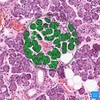Airway disease Flashcards
Obstructive airway diseases
a disease that causes obstruction affects all of the airways in both lungs - global airway obstruction.
not including lung cancer, tumour, inhaled foreign bodies and chronic scarring diseases like bronchiectasis and secondary fibrocaseous or tuberculosis as these are not primarily obstructive diseases.
In relation to obstructive diseases how can we measure function?
testing with FEV1 and FVC
take a deep breath in and try blowing out as much air as possible and as fast as possible.
fev1 - forced expiratory volume of air in first second
fev1 is usually about 70%-80% of fvc
normal fev 1 is about 2.5-4L
normal fvc is about 5L
normal ratio fev1:fvc is 0.7 -0.8
what % is normal fev1 of fvc
fev1 is usually about 70%-80% of fvc
what is normal fev1 volume
normal fev 1 is about 2.5-4L
what is normal fvc volume
normal fvc is about 5L
what is normal ratio fev1:fvc
normal ratio fev1:fvc is 0.7 -0.8
what is another way to measure airflow limitation other than fev1/fvc
peak flow
what is normal peak expiratory flow rate?
400-600litres per min
what is a normal peak expiratory flow rate range %
80-100%
what is the % of a moderate fail of a peak expiratory flow rate?
50-80%
what is a maked fail of a peak expiratory flor rate %?
<50%
explain asthma what is it?
type 1 hypersensitivity in the airways because of bronchial constriction
reduction in the luminal cross-sectional area. granulation of mast cells in airways releasing chemical factors from mast cells reduce diameter.
In asthma what do the chemical factors do in the airway
chemical factors induce inflammation by attracting inflammatory cells = swelling and oedema within the bronchial mucosa.
chemicals have a direct effect on bronchial smooth muscle leading to constriction of airways.
= airflow narrowing and limitation
is bronchial asthma reversible?
yes generally reversible obstruction spontaneously or with medical intervention
the bronchial smooth muscle contraction and inflammation can be modified with drugs.
aetiology of chronic bronchitis and emphysema
SMOKING
- atmospheric pollution
occupation: dust
alpha1 antiprotease (antitrypsin) deficiency extremely rare cause of emphysema
- age and susceptibility
prevalence - men more than women
increasing in developing countries
Chronic bronchitis is defined clinically as:
cough productive of sputum most days in at least 3 consecutive months for 2 or more consecutive years
(excludes tb, bronchiectasis)
clinically may be confused with chronic bronchial asthma
complicated chronic bronchitis when sputum turns mucopurulent (acute infective exacerbation) or FEV1 falls
What are the morphological changes in chronic bronchitis
large airways: mucus gland hyperplasia, goblet cell hyperplasia, inflammation and fibrosis is a minor component
small airways: goblet cells appear, inflammation and fibrosis in long-standing disease.
explain globlet cells
Modified epithelial cells that secrete mucus on the surface of mucous membranes of intestines and airways
Their role is to protect the surface of the epithelium, lubricate it, and catch harmful particles. Although protective, goblet cells may be involved in the pathophysiology of certain respiratory diseases, such as chronic bronchitis.

define emphysema
pathological definition: increase beyond the normal in the size of airspaces distal to the terminal bronchiole arising either from dilation or from the destruction of their walls and without obvious fibrosis
what is the acinus?
the gas exchange tissue part of the lunch and is defined by everything distal to the terminal bronchiole

histology emphysema
the air spaces become bigger - loss of alveolar walls

most common form of emphysema
centri-acinar emphysema
middle of acinus - middle disappears - holes surrounded by lung tissue

what is pari-acinar emphysema
holes all alveolar and acinous gas exchange lost. scarring is irregular and has “bullous” emphysema. bullae are spaces under the pleura full of air. This is significant because if they pop, this can cause pneumothorax
mechanisms airway in COPD.
small airways smooth muscle tone and inflammation - will respond to same drugs as asthma - inflammation component will respond. the fibrotic element will not, however.
Why i t isn’t reversible what cannot be treated is emphysema - the loos of alveolar attachment is most important


